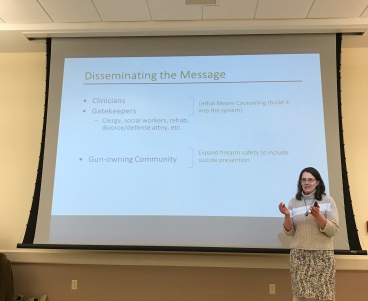On April 5, 2019 The Suicide Prevention Center of New York held the “Means Reduction Academy” in Albany, NY. The topic of means reduction is complex and often requires a multi-disciplinary approach. Approximately of half deaths by suicide are by firearm. The study of means reduction sought to understand if there are ways to reduce access to firearms for suicidal individuals. This issue often becomes political as gun rights advocates often cringe at the thought of infringing on second amendment rights. Clinicians are often quick to wonder how we can legally take guns away from suicidal individuals.
Using a multi-disciplinary approach, trainers demonstrated how it is possible to focus on data, put politics aside, come to a shared definitions of the problem, and most importantly take action. 2 leading public health experts (Eliane Frank of Dartmouth-Hitchcock and Catherine Barber of Harvard Chan School of public health) and two leaders in the gun community (John Yule of The Wildlife Taxidermy and Sports Center and Ralph Demico, VP of Gun Owners of New Hampshire) presented as a team. They created a unique partnership in New Hampshire and shared lessons they learned and other effective campaigns.
First Catherine laid out the public health data on why means matter. She first gave the example of the Sri Lanka was struggling with Pesticides as a means for suicide. It was a highly lethal means and was available easily due to the need in the country. They recognized the need, created a public health campaign, and reduced the risk. She described how means reduction in guns requires a similar intervention. That guns are incredibly lethal means but and we can do something about it.


Identifying lethal means is important but what is even more critical is that suicidal thoughts are often time limited and time and space from lethal means is the key intervention.

These are the key points why reducing access to lethal means.

Members from the New Hampshire gun community ended up partnering with both Catherine and Elaine Frank. Both Ralph and John underscored the importance of not jumping to conclusions about those who own guns. Also if you don’t know the answer to something, its’s best to ask. They talked about the need for clinicians to understand how guns work. That certain terminology matters. That instead of referring to something as a “clip” it is called a magazine. And rather than referring to guns as “weapons” refer them to “fire arms”. It matters when discussing messaging which will examine further in a bit.
Clinically, Elaine Frank worked participant through the basics of C.A.L.M (Counseling On Lethal Means). This is a one hour free training on how clinicians can begin to have a conversation with clients in crisis about reducing access to guns. The emphasis is not taking legal action but how one can develop shared decisions with clients around this. The emphasis is working together to co-create a plan to keep one safe. This is a valuable training that all clinicians should take an hour of their time to enroll in.
The conference ended with some example of PSA’s and messaging for public health campaigns. They provided a powerful example of a public service announcement in Utah called “Is Your Safety On?” This brief video is a good summary of how we need to frame this issue..
You can find more information about the Utah Campaign and resources about Means Reduction are available at the Suicide Prevention Resource Center website. These examples highlight the need for those interested in the public health space to partner with gun groups around these messages. Also American Foundation For Suicide Prevention partnered with the National Shooting Sports Foundation to develop educational materials on guns and suicide. This is another example of how groups can come together around a shared understanding of the problem.

It was mentioned several times how we need to come together not “against guns” but being “anti-suicide”. We can achieve this by working together to understand the numbers effected, the means, and come to a shared understanding of the problem. The solutions are complex but together we can temporarily reduce lethal means for those in crisis.
Sean Erreger, LCSW
Co-Chair Rensselaer County Suicide Prevention Task Force
